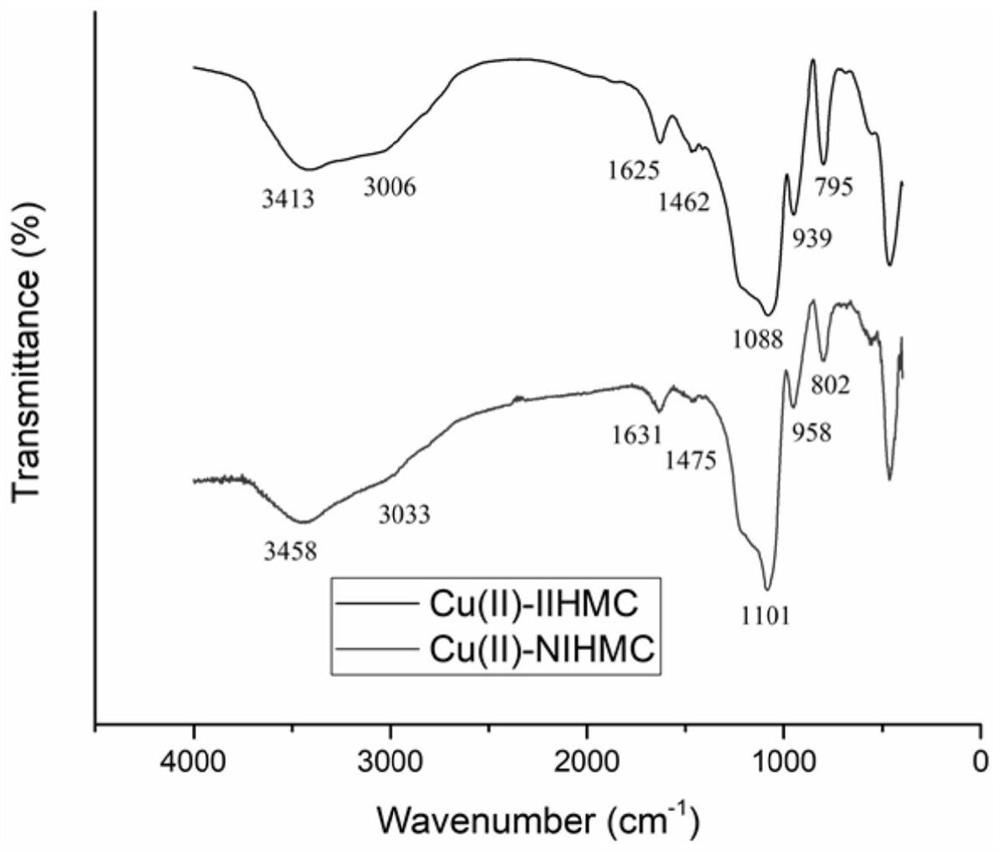Copper ion imprinted organic-inorganic hybrid monolithic column as well as preparation method and application thereof
A copper ion, monolithic column technology, applied in the field of detection, can solve the problems of cumbersome and time-consuming preparation process, poor stability, limited selectivity, etc., and achieve strong mechanical and chemical stability, strong anti-interference ability, and good selectivity. Effect
- Summary
- Abstract
- Description
- Claims
- Application Information
AI Technical Summary
Problems solved by technology
Method used
Image
Examples
preparation example Construction
[0041] The preparation of copper ion imprinted monolith mainly includes three steps: formation of Cu(II) complex, hydrolysis of silane reagent and polycondensation between silane monomers. Therefore, the type and amount of amino reagents are the most important factors in the preparation process. During the experiment, 3-[2-(2-aminoethylamino)ethylamino]propyl-trimethoxysilane (AAAPTES) was used as amino reagent, but AAAPTES and Cu 2+ The resulting hydrophilic Cu(II) complex has low solubility in a binary solvent system composed of ethanol and water, which makes it impossible to synthesize satisfactory imprinted materials. In addition, during the experiment, a variety of solvent systems have been tried, such as methanol, isopropanol, N,N-dimethylformamide and combinations of various solvents, but none of them can solve the above problems. Then, after a lot of research, it was surprisingly found that using AEAPTES as a functional monomer can well solve the solubility problem of...
Embodiment 1
[0050] In this example, actual samples such as rainwater, lake water, atmospheric particulate matter (PM3.3-10), and iron ore are taken as examples, and they are respectively digested into solutions, and a needle solid phase based on copper ion imprinted organic-inorganic hybrid monolithic column is used. Microextraction was used to determine the concentration of Cu(II) in it.
[0051] Such as Figure 4 As shown, the application of a copper ion imprinted organic-inorganic hybrid monolithic column in this embodiment in the separation and enrichment of copper ions, the specific steps are:
[0052] 1. Preparation of copper ion imprinted organic-inorganic hybrid monolithic column
[0053] (1) Capillary activation: sequentially use 1.5mol L at room temperature -1 Rinse the capillary with NaOH solution for 10 hours and ultrapure water for 30 minutes, 1.5mol L -1 Rinse with HCl solution for 10h, ultrapure water for 30min, and anhydrous methanol for 30min; 2 Dry the capillary unde...
Embodiment 2
[0070] This embodiment mainly investigates the influence of the SPME method on the analysis results of Cu(II) in three standard materials of GSD-2 (sediment), GSS-3 (soil), and ZBK309 (iron ore). Among them, GSD-2 (sediment), GSS-3 (soil), and ZBK309 (iron ore) are used as three standard substances.
[0071] Using the SPME method based on the copper ion imprinted organic-inorganic hybrid monolithic column obtained in Example 1 and directly using ICP-MS (without using the SPME method) for Cu(II) in the standard substance GSD-2, GSS-3 and ZBK309 The specific experimental results are shown in Table 2.
[0072] Table 2 The analysis results of Cu(II) in standard materials GSD-2, GSS-3 and ZBK309 with and without SPME method
[0073] (mean ± standard deviation, n = 3)
[0074]
[0075] It can be seen from Table 2 that compared with the direct use of ICP-MS, the concentration accuracy of Cu(II) measured by the SPME method based on copper ion imprinted organic-inorganic hybrid mo...
PUM
 Login to View More
Login to View More Abstract
Description
Claims
Application Information
 Login to View More
Login to View More - R&D
- Intellectual Property
- Life Sciences
- Materials
- Tech Scout
- Unparalleled Data Quality
- Higher Quality Content
- 60% Fewer Hallucinations
Browse by: Latest US Patents, China's latest patents, Technical Efficacy Thesaurus, Application Domain, Technology Topic, Popular Technical Reports.
© 2025 PatSnap. All rights reserved.Legal|Privacy policy|Modern Slavery Act Transparency Statement|Sitemap|About US| Contact US: help@patsnap.com



